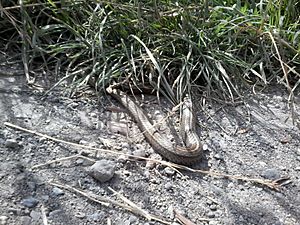Galvarinus chilensis facts for kids
Quick facts for kids Galvarinus chilensis |
|
|---|---|
 |
|
| Conservation status | |
| Scientific classification |
The Chilean slender snake (Galvarinus chilensis) is a type of snake found in South America. It belongs to the Colubridae family, which is a very large group of snakes. These snakes are known for being non-venomous, meaning they are not harmful to humans. The Chilean slender snake lives in parts of Chile and Argentina. It was first described by a scientist named Hermann Schlegel in 1837.
Contents
What is the Chilean Slender Snake?
The Chilean slender snake is a small to medium-sized snake. It gets its name "slender" because it has a thin body. These snakes are usually brown or gray, often with darker spots or stripes along their back. This coloring helps them blend in with their surroundings, making it harder for predators to spot them. They have smooth scales and a pointed head.
Where Do They Live?
This snake lives in different parts of Chile and Argentina. They can be found in various habitats, including forests, grasslands, and even rocky areas. They prefer places where they can find plenty of food and good hiding spots. Their ability to live in different environments shows how adaptable they are.
Climate and Habitat
In Chile, they are often found in the central and southern regions. In Argentina, they live in the western parts, especially near the Andes Mountains. These areas have different climates, from dry to more humid. The snakes often hide under rocks, logs, or in burrows to stay safe from predators and extreme weather.
What Do They Eat?
The Chilean slender snake is a carnivore, which means it eats other animals. Their diet mainly includes small prey. They are active hunters and use their quick movements to catch food.
Hunting and Diet
These snakes typically eat small lizards, frogs, and insects. Sometimes, they might also eat small rodents or other invertebrates. They hunt during the day, using their sense of smell and sight to find their prey. Once they catch their prey, they swallow it whole.
Life Cycle and Reproduction
Like most snakes, the Chilean slender snake goes through a life cycle that includes hatching from eggs or being born live. Snakes are reptiles, and their reproduction methods can vary.
How They Reproduce
Most snakes in the Colubridae family lay eggs, but some give birth to live young. Scientists study these snakes to understand their specific reproduction habits. Female snakes will find a safe place to lay their eggs, often in hidden spots like under rocks or in decaying logs. The eggs will then hatch, and tiny baby snakes will emerge. These young snakes are usually ready to take care of themselves from birth.
Conservation Status
The Chilean slender snake is listed as "Near Threatened" (NT) by the International Union for Conservation of Nature (IUCN). This means that while it is not currently endangered, its population might be at risk in the future.
Threats to Their Survival
One of the main threats to these snakes is habitat loss. As human populations grow, natural areas are often changed for farming, building, or other uses. This reduces the places where snakes can live and find food. Other threats can include climate change and sometimes being hunted by humans who might mistake them for dangerous snakes.
How We Can Help
Protecting their natural habitats is very important. This includes creating protected areas and making sure that human activities do not destroy their homes. Learning more about these snakes and their role in the ecosystem can also help people understand why they are important to protect.
See also
 In Spanish: Culebra de cola corta para niños
In Spanish: Culebra de cola corta para niños


